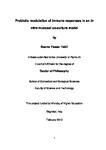Probiotic Modulation of Mucosal Immune Responses in an In Vitro Co-Culture Model
| dc.contributor.supervisor | Foey, Andrew | |
| dc.contributor.author | Habil, Neama | |
| dc.contributor.other | School of Biomedical Sciences | en_US |
| dc.date.accessioned | 2014-10-07T08:58:31Z | |
| dc.date.available | 2014-10-07T08:58:31Z | |
| dc.date.issued | 2013 | |
| dc.identifier | 10211457 | en_US |
| dc.identifier.uri | http://hdl.handle.net/10026.1/3132 | |
| dc.description.abstract |
Probiotics confer health benefits through many mechanisms including modulation of the gut immune system. Gut mucosal macrophages play a pivotal role in driving mucosal immune responses. The local environment and macrophage subset determine immune response: tolerance, associated with an M2-like, regulatory macrophage phenotype and inflammatory activation with an M1-like phenotype. The aims of this study were firstly to investigate the immunomodulatory effects of a panel of heat-killed (HK) probiotic bacteria and their secreted proteins (SP) of Bifidobacterium breve (BB), Lactobacillus rhamnosus GG (LR), L. salivarius (LS), L. plantarum (LP), L. ferrmentum (LF), and L. casei strain Shirota (LcS) on cytokine production and TLR expression in monocultures of monocytes, macrophage subsets, and intestinal epithelial cells. Normally, mucosal gut macrophages resemble the M2 subset and fail to express CD14, a co-receptor for LPS signalling. Therefore, probiotic modulation of LPS-induced NF-kB activity and cytokine expression was investigated using a THP-1 monocyte-derived reporter cell line, model of CD14 hi / lo M1 and M2 macrophages. Secondly, a transwell co-culture system was developed to investigate probiotic modulation of macrophage-influenced epithelial barrier function. Parameters investigated included cytokine, TLR and hBD-2 expression, TEER and IHC staining of the tight junction protein, ZO-1. Probiotics selectively modulated monocyte and macrophage subset cytokine expression. Probiotics (HK and SP) suppress CD14 lo , augment CD14 hi M1, and differentially regulated TNF-α production in M2s. M2 macrophage IL-6 production was suppressed by both HK and SPs, and differentially regulated in CD14 lo and CD14 hi M1s. NF-κB activation failed to parallel probiotic regulation of TNF-α and IL-6. Probiotics (HK-LF and HK-LcS) selectively modulated both endogenous and exogenous TNF-α and IL-10, as well as their induction of epithelial cell expression of TLR and hBD-2. Epithelial expression of TEER, ZO-1 and the endogenous TLR signal regulator, Tollip, were suppressed upon co-culture with pro-inflammatory M1 macrophages paralleled by a suppression of IL-10 and up-regulation of TNF-α and IL-8. In the presence of LPS, HK-LF enhanced TEER, ZO-1 and partially rescued Tollip expression, whereas HK-LcS had no effect on TEER and ZO-1 and displayed a weaker rescue effect on Tollip compared with LF. In the M2/epithelial cell co-culture, both probiotics enhanced TEER and ZO-1 in the presence of LPS, whilst displaying a differential modulation of Tollip, dependant on the format of probiotic (HK or SP). In conclusion, probiotic strains can differentially exert immune activatory or suppressive functions and immunomodulation is determined by strain, inflammatory environment, and mucosal macrophage effector phenotype. Future probiotic development must consider prophylactic use in healthy individuals or therapeutic treatment of defined pathological conditions, strain-specific effects, gut mucosal integrity, and immune phenotype of mucosal macrophages. | en_US |
| dc.description.sponsorship | Ministry of Higher Education Baghdad, Iraq | en_US |
| dc.language.iso | en | en_US |
| dc.publisher | Plymouth University | en_US |
| dc.subject | Mucosal Immunology, Probiotic | en_US |
| dc.subject | macrophage, inflammation | en_US |
| dc.title | Probiotic Modulation of Mucosal Immune Responses in an In Vitro Co-Culture Model | en_US |
| dc.type | Thesis | en_US |
| plymouth.version | Full version | en_US |
| dc.identifier.doi | http://dx.doi.org/10.24382/1384 | |
| dc.identifier.doi | http://dx.doi.org/10.24382/1384 |
Files in this item
This item appears in the following Collection(s)
-
01 Research Theses Main Collection
Research Theses Main


